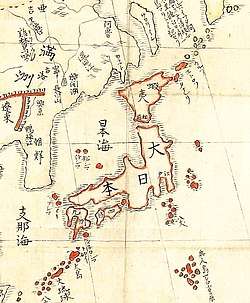Jishō
Jishō (治承) was a Japanese era name (年号, nengō, "year name") after Angen and before Yōwa. This period spanned the years from August 1177 through July 1181.[1] The reigning emperors were Takakura-tennō (高倉天皇) and Antoku-tennō (安徳天皇).[2]
| History of Japan |
|---|
 |
Change of era
- 1177 Jishō gannen (治承元年): The new era name was created to mark an event or a number of events. The previous era ended and a new one commenced in Angen 3, on the 4th day of the 8th month of 1177.[3]
Events of the Jishō era
- 1177 (Jishō 1, 28th day of the 4th month): A great fire in the capital was spread by high winds; and the palace was reduced to cinders.[4]
- 1178 (Jishō 2, 12th day of the 11th month): Emperor Takakura's consort, Tokuko, gives birth to an infant who will become Emperor Antoku.[5]
- 1180 (Jisho 4, 21st day of the 2nd month): Emperor Takakura abdicates.[5]
- 1180 (Jishō 4, 21st day of the 4th month): In the 12th year of Takakura-tennō 's reign (高倉天皇12年), the emperor was forced to abdicate; and the succession (senso) was received by his infant son, the grandson of Taira Kiyomori.[6]
- 1180 (Jisho 4, 22nd day of the 4th month): Emperor Antoku's is said to have acceded to the throne (sokui) on the day of his cornonation ceremony.[7]
- 1180 (Jisho 4, 2nd day of the 6th month): Former-Emperor Go-Shirakawa-in, former-emperor Takakura-in and Emperor Antoku leave Kyoto for Fukuhara, which is near modern-day Kōbe, Hyōgo.[5]
- 1180 (Jisho 4, 26th day of the 11th month): The capital is moved back to Kyoto from Fukuhara.[8]
- 1180 (Jisho 4): A devastating whirlwind causes havoc in Heian-kyō, the capital.[9]
- 1181 (Jisho 5, 14th day of the 1st month): Emperor Takakura dies.[5]
- 1181 (Jisho 5, 25th day of the 4th month): Battle of Sunomata-gawa
gollark: I don't live in Indiana, I live in the Freeish State of Gollarkia.
gollark: For legal reasons, we are not able to provide answers with greater than 25% accuracy.
gollark: Plus or minus 30.
gollark: 64 + 30 = 87.0003
gollark: The existing Soviet Forth builtins are basically horrible, but these are particularly bad.
References
- Nussbaum, Louis-Frédéric. (2005). "Jishō" in Japan Encyclopedia, p. 425, p. 425, at Google Books; n.b., Louis-Frédéric is pseudonym of Louis-Frédéric Nussbaum, see Deutsche Nationalbibliothek Authority File Archived 2012-05-24 at Archive.today.
- Titsingh, Isaac. (1834). Annales des empereurs du Japon, pp. 195–200; Brown, Delmer et al. (1979). Gukanshō, pp. 330–333; Varley, H. Paul. (1980). Jinnō Shōtōki. pp. 212–214.
- Brown, p. 332.
- Titsigh, p. 198; Kitagawa, H. (1975). The Tale of the Heike, p. 783; Kamo no Chōmei. (1212). Hōjōki.
- Kitagawa, H. (1975). The Tale of the Heike, p. 784.
- Titsingh, p. 200; Brown, p. 333; Kitagawa, p. 784; Varley, p. 44; a distinct act of senso is unrecognized prior to Emperor Tenji; and all sovereigns except Jitō, Yōzei, Go-Toba, and Fushimi have senso and sokui in the same year until the reign of Emperor Go-Murakami.
- Kitagawa, p. 784; Varley, p. 44.
- Kitagawa, p. 785.
- Kamo no Chōmei. (1212). Hōjōki.
General
- Brown, Delmer M. and Ichirō Ishida, eds. (1979). Gukanshō: The Future and the Past. Berkeley: University of California Press. ISBN 978-0-520-03460-0; OCLC 251325323
- Nussbaum, Louis-Frédéric and Käthe Roth. (2005). Japan encyclopedia. Cambridge: Harvard University Press. ISBN 978-0-674-01753-5; OCLC 58053128
- Titsingh, Isaac. (1834). Nihon Ōdai Ichiran; ou, Annales des empereurs du Japon. Paris: Royal Asiatic Society, Oriental Translation Fund of Great Britain and Ireland. OCLC 5850691
- Varley, H. Paul. (1980). A Chronicle of Gods and Sovereigns: Jinnō Shōtōki of Kitabatake Chikafusa. New York: Columbia University Press. ISBN 9780231049405; OCLC 6042764
External links
- National Diet Library, "The Japanese Calendar" -- historical overview plus illustrative images from library's collection
| Preceded by Angen |
Era or nengō Jishō 1177–1181 |
Succeeded by Yōwa |
This article is issued from Wikipedia. The text is licensed under Creative Commons - Attribution - Sharealike. Additional terms may apply for the media files.